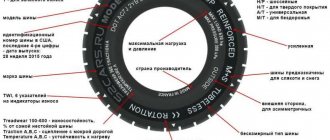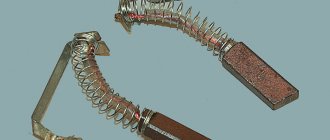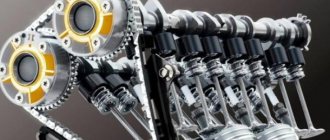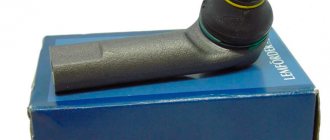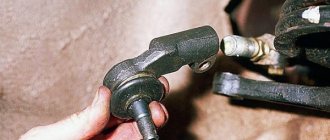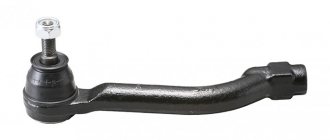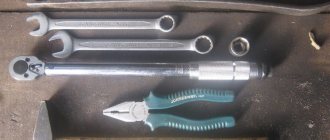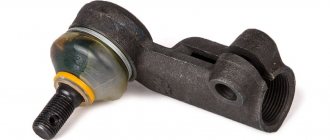So I decided to make an article about various noises and sounds produced by mechanical components during malfunctions)
Sometimes you feel like you don’t want to grunt, but then decide whether it’s dangerous or not. Various extraneous sounds in the car are an alarm signal and serve as a reason to once again pay attention to its technical condition.
Knock
- this is a backlash formed in any unit.
It often occurs from natural wear and tear of this unit. The noise
comes from rubbing parts. The noises and knocks are very similar to each other.
In addition, very often they add up, for example, the ball joints are faulty and there is play in the front hub bearings or steering tips.
How can I find out exactly which unit this knocking/noise is coming from?
To determine the location of the noise and/or knocking, you must first determine which side it is coming from, front or rear, left or right. If you have already established the approximate location of the noise, then finding it will be much easier. Observations will also help: what the sound is synchronized with and under what conditions it occurs.
At the same time, look at the remaining paragraphs - perhaps you attributed the observed sound to the wrong section from where it is heard. This is due to the fact that some vehicle systems are extended (for example, the exhaust tract). In addition, sound travels well through metal and can be heard from places other than where it originates.
Sounds from the front of the car
The front wheel bearings are making knocking and/or noise.
The knocking noise occurs from excessive play in the bearings, and the noise is due to wear on the raceway of the cages and bearing rollers.
Diagnostics can be carried out on a level platform, inspection ditch or lift.
Test No. 1.
Raise the left side of the car with a jack (or a standard one) (for safety, place a stand under the car). Spin the wheel sharply by hand. It should turn without making a noise, which is similar to the noise of a large metal ball rolling on a flat metal surface. If such a sound is present, then it means that the raceways of the cages and bearing rollers are worn out. In this case, the bearings must be replaced.
Test No. 2.
With your left hand, grasp the upper inner part of the wheel, and with your right hand, the lower outer part. Rock the wheel until it breaks. If the wheel does not wobble and there are no extraneous knocks, then everything is OK. If it is loose, eliminate the play in the hub bearing.
Ball joints are making knocking and/or squeaking noises. These sounds are clearly audible when driving over bumps and on uneven roads.
Carry out diagnostics on a flat area, overpass or inspection ditch, but under no circumstances on a lift. Otherwise, the suspension will be loaded, and you will not be able to determine the malfunction of the ball joints. It is more convenient to work together.
To identify the problem, lift the vehicle by the lower arm using a hydraulic or screw jack. If such a jack is not available, then you can use a standard one. Lift the car with it, and then place a wooden block under the lower arm and lower the car onto it. With your left hand, grasp the upper inner part of the wheel, and with your right hand, the lower outer part. Rock the wheel until it breaks. The second person, placing his hand alternately on the upper and lower parts of the steering knuckle at the attachment points of the ball joints, must determine which of them has play. Replace the faulty support. Sometimes play occurs in two supports at once.
How to diagnose rods and tips yourself?
Most modern machines do not have free access to these nodes. Manufacturers prudently install special plastic covers on the engine that do not allow you to look into the main systems. But on budget vehicles, you can easily find the location of the steering rack, and also view the operation of the tips, which are accessible under the wheel arches. Despite such easy access, you need to know how to diagnose these products. Otherwise, the verification process will not be able to proceed efficiently.
So, the main diagnostic features:
- you need to understand that two parts in the rods fail - the thread where the tip is screwed on and the silent block connecting the rod to the rack, if your design has one;
- you need to put an assistant behind the wheel, ask him to swing the steering wheel from lock to lock, and grab the rod with your hand, seeing where a slight knock appears, also visually inspect the silent blocks;
- next you need to turn the wheels all the way to the left and approach the left side, putting your hand under the arch, feel the tip and pull it, there may be only a barely noticeable play;
- repeat the same operation with the tip on the right side, turning the steering wheel all the way to the right, usually this is enough to obtain information about the state of this system, but that’s not all;
- also carefully inspect all rubber seals, boots and fasteners to ensure that they do not have cracks, tears, or signs of wear, otherwise they should be replaced immediately.
The steering system should be checked twice a year. This is usually done before and after the winter season. It is in winter that inaccurate steering will cause significant problems with your car and the safety of your trip. If the steering system works well, then there will be no problems with its operation in any season. It is very important to carry out diagnostic work carefully. You will need a quality flashlight to see the parts hidden in the various cavities. You will spend 10 minutes, but you will know for sure that everything is fine with these parts.
The main reasons for wear of steering tips
The steering mechanism in a car is rightly considered one of the most critical components. The controllability of the machine and the safety of movement on it depend on the serviceability of this system. The steering unit includes tips and rods. The turning process occurs thanks to a gearbox or rack. The force from the steering wheel is transmitted to the steering knuckles through rods, the ends of which have hinges. To correctly identify signs of malfunction of the described parts, you need to have an understanding of their structure.
What are the signs of an urgent need for steering system repair?
Usually cars nowadays are equipped with amplifiers, so not all problems are immediately felt on the steering wheel. The steering rack takes the blow, and this may not affect the overall operation of the mechanism. But at a certain period, problems will emerge that can lead to serious consequences. Therefore, you should be careful about any, even minimal, changes in the car system. Otherwise, the problems may turn out to be catastrophic. On cars without amplifiers, malfunctions of this mechanism are felt better.
You should remember these important signs of imminent repair:
- with the car turned off, when the steering wheel is vigorously twitched at the extreme points of free wheeling, a barely perceptible knock is heard - you must definitely find the cause of this knock;
- with the car running, when the amplifier is already working, in extreme free-wheel modes of the steering wheel, strong knocks are heard, usually they give a certain feedback to the driver’s hands;
- if the steering wheel is turned half a turn, you can twitch it and hear even stronger knocks in the area of the steering rack, this already indicates a malfunction of the rack itself;
- during the trip, a strong knock is heard in the front suspension, very often it is not about the suspension, but about the steering systems, they rattle more than a failed strut, and there is also feedback on the steering wheel;
- When driving over small bumps in the road, the steering wheel reacts to such obstacles, it is very difficult to catch the direction of the car, you have to constantly steer while driving.
The last feature often indicates that there are strong backlashes in the area of the rods and tips. Also, often the steering wheel travel becomes too light, and the amplifier turns on at full power. Even if there is no knocking, but the operating characteristics of the amplifier have changed significantly, it is worth carefully checking the steering. It is quite possible that it is enough to change the tips, paying relatively little money. If you drive further, the dead steering tips will gradually begin to kill the entire car. This clearly will not lead to increased driving safety.
Symptoms
If you ignore a faulty steering linkage, at the first strong impact on an obstacle or falling into a hole, the finger is simply torn out of its socket. As a result, the car becomes uncontrollable, because the wheel ceases to obey the influence of the steering mechanism. How to check the tips? You need to take a closer look and listen to the symptoms:
An important point: all of the above signs of faulty steering tips may indicate that there is wear on the pendulum or bipod bearing. Therefore, you should first carefully check the condition of the tips.
How to choose good spare parts for the steering system?
Let's say you found a problem and want to fix it. In this case, you will need to purchase ends, linkages or steering assemblies. There are dozens of manufacturers who offer their solutions in this case. But the problem is that most of them are not worthy of your attention. You should be very careful about the fact that a variety of difficulties may arise during the operation of inexpensive spare parts. When selecting, you should carefully evaluate several important factors and choose the optimal parts.
Here are just a few features to consider:
- brand - not always a well-known brand produces good spare parts for your car; famous factories are also represented on the Russian market in a huge number of fakes;
- price - a good spare part cannot be three times cheaper than the original one, it is important to refuse to purchase very cheap rods and ends, as this is simply unsafe for you;
- appearance - inspect the parts and make sure that they were produced on good industrial equipment, this can usually be seen by various criteria, including the quality of metal preparation;
- packaging - most high-quality automobile parts are packed in sealed film, as well as in a cardboard box; the lack of packaging indicates a fake or defective product;
- supplier - do not buy components for your car in unverified places, this can be very dangerous for your vehicle and cause its obvious problems.
It is best to take original spare parts, even if this is the most expensive option. However, originals sometimes cost unreasonably a lot of money. This suggests that it is worth paying more attention to suppliers. Sometimes the original can be bought in a third-party store for half the price than on the official service. Officials make money on spare parts, this is their main business. But when buying in a regular store, be very careful and avoid purchasing obvious fakes. You definitely won't get any benefit from them.
Check while driving
Failure of the steering tips can be determined by the behavior of the car while driving. While driving a car on a safe section of the road, you need to make several small turns with the steering wheel. If the wheels turn with some delay, this indicates the presence of play, which is caused by increased gaps between the hinge and the tip body. Also, a malfunction can be indicated by extraneous sounds that occur while driving the car.
Self-replacement - is it worth getting involved?
If you have a modern car with a technologically advanced steering system, it will be much easier and more convenient to contact specialists from a trusted station and get a pleasant, quick repair with minimal time and without the risk of poor-quality work. Domestic cars and budget foreign cars can be repaired in your own garage if you have a pit and experience in performing certain work. You won’t be able to do anything according to the instructions from the first video you come across, you need experience, and the help of a friend with experience in this matter will not be superfluous.
The main disadvantages of self-repair:
- this will take some time, sometimes replacing rods and ends at a service center takes about 2-3 hours, in a garage it can take much longer, and this does not make the car owner very happy;
- installation inaccuracies will cause problems in the steering, after a couple of hundred kilometers problems will begin that will certainly lead to another expensive repair;
- you are unlikely to enjoy this work; you will most likely end up with a number of troubles associated with an inconvenient position or the inability to unscrew a certain bolt;
- you need to understand exactly how the parts are installed, in what order it is necessary to disassemble the equipment, otherwise troubles may arise from an assembly point of view;
- After completing the work, it is necessary to carry out a series of tests before driving on public roads, this is important to do even if you are very confident in the quality of your work.
Changing tie rods and steering ends is not as easy as it might seem at first glance. You need to understand that this procedure is very responsible, so it is better to contact the service if you have any doubts. Also, if problems arise during the repair process, it will not be easy for you to call a specialist to your garage to finish assembling the equipment. So it’s much better to get the job done right away in a good service. But if you have experience and confidence in your abilities, you can save a couple of thousand rubles without any problems.
We invite you to watch a video with the process of replacing rods and tips:
Symptoms of malfunctions
If you do not pay attention to the wear of the tie rod ends, the ball pin will become loose and jump out of its socket at the first decent bump. There is no need to explain for a long time what this entails: the wheel will become uncontrollable, and the driver will lose control of the car. How to determine that there are problems with the hinges and the car’s chassis needs to be checked:
Note. Unfortunately, such signs are observed not only as a result of problems with the steering rack, but also as a result of wear of the bearing of the rotary bipod and the pendulum. The exact result will be shown by a check performed by car service employees or independently in a garage.
If you find one of the listed symptoms in your own car, you should not delay diagnosis. Especially if the tips have served more than 40 thousand kilometers. To perform the check, you will need an inspection ditch; hanging the car on a jack will not allow you to swing the rod in the desired direction.
To check the tie rod ends yourself, use the step-by-step instructions:
Advice. When swinging the rod, do not confuse the hinge play with free play of the steering rack or a broken pendulum bearing.
To check the integrity of the anthers, an inspection hole is not needed. It is enough to turn the wheel and lift the car with a jack. The hole in the rubber boot is discovered thanks to thick lubricant, which is squeezed out from the inside through a gust.
Replacing the steering tip is also not a big problem; the only special tools you need are a puller to push the ball pin out of the steering knuckle eye. Please note an important nuance: after replacing the linkage, the camber angles of the wheels must be adjusted. You cannot make the adjustment yourself, so you will have to visit a car service center.
Source
Let's sum it up
It is important to timely repair the technical part of your car if something goes wrong. You should be attentive to the quality of performance of any tasks during the car repair process, since your confidence on the road will depend on this. This is especially important if you are dealing with steering issues. Tips in Russia fail quite quickly. In Europe they last up to 12 years, in Russia - up to 5 years on high-quality machines. In most cases, problems are associated with poor operating conditions. If these parts fail, you should very carefully diagnose and replace the elements that led to unpleasant consequences.
Many companies today offer remanufacturing of rods and ends. But usually this doesn't make sense. You will pay money, but after a few months you will get the same problems. It is almost impossible to repair these parts. Even with modern equipment, repairs will be extremely difficult due to deformation, metal rusting and other unpleasant aspects that cannot be restored. So be as attentive as possible to steering repair issues and promptly eliminate troubles in your car associated with these features.
Design
Externally, the tip is a steel rod, at one end of which there is a hinge, at the other there is a thread that serves for connection to a rack or gearbox. The tip pin is inserted into a special hole in the fist and secured with a nut and cotter pin. In more detail, the rod end consists of:
The last element is necessary so that the pin rotates freely in any direction, and thanks to the spring, the backlash that occurs during operation of the car is eliminated for some time. If the tip fails, the part is replaced entirely, since it has a non-separable design. There are also composite parts that were once popular in the Soviet Union (due to a shortage of spare parts), but they are practically not used today due to low reliability.
Revealing the essence of the problem
The answer to the question of how to check tie rod ends is not difficult. The inspection itself is not difficult. Initially, you can assess the degree of wear of the tips when driving on uneven roads or when accelerating (braking). In this case, it is possible to feel play on the steering rack and a slight kickback in the fuel adjustment pedal.
To conduct a more detailed inspection, you need to jack up the car and remove the wheel. Then, having reached the steering rod, find the tip. The first step is to press the hinge from above, resting your fingers on the nut from below.
If it can be compressed and play is felt, then it means that the spherical part is already worn out and the element needs to be replaced. But this play when pressed may not be detected the first time. It is necessary to turn the steering wheel to different positions and repeat the procedure until the steering wheel is in almost all positions. It happens that it can dangle up and down only every other time.
You also need to check the anthers
. In order to check the serviceability of the ball joint without removing the wheel, you need to rock the wheel in different positions with your foot; if you feel wobbly and metallic sounds, then you need to remove the wheel and inspect the steering joint in detail.
Checking in a garage
If a check while the vehicle is moving shows that the steering tips are likely to be faulty, they should be checked in the parking position. The car is installed above the inspection hole, and if there is no inspection hole, the front of the car is raised on jacks. For better visibility, the front wheels are temporarily removed.
There are 3 types of tie rod end malfunctions: mechanical damage and deformation, depressurization of rubber seals, and the presence of play. Defects in rubber seals allow contaminants to enter the lubricant, which can lead to mechanical damage to the spherical joint.
In all cases of detection of malfunctions, the steering tip must be replaced. When purchasing a new tip, you should check that the serial part number indicated on the body matches.
